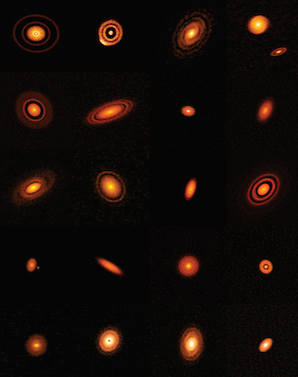20 Ring Worlds
 In a team of 17 scientists lead by Sean Andrews, we carried out the Disk Substructures at High Spatial Resolution Project, or DSHARP in short. This consists of over 60 hours of ALMA observations for 20 planet forming disks designed to study the occurrence, forms, locations, sizes, and other properties of structures in the disk material and how they might be related to the planet formation process.
In a team of 17 scientists lead by Sean Andrews, we carried out the Disk Substructures at High Spatial Resolution Project, or DSHARP in short. This consists of over 60 hours of ALMA observations for 20 planet forming disks designed to study the occurrence, forms, locations, sizes, and other properties of structures in the disk material and how they might be related to the planet formation process.We found that rings are everywhere, while spirals and asymmetries are sometimes present but rare. The positions of the rings show no correlation with the stellar brightness, which basically rules out that condensation fronts are responsible for the rings. Together with the other recent ALMA result (see three baby planets detected) this seems to indicate the planets form abundantly and faster than expected. At the same time, these results also open new questions, for example: why do all rings seem to be equally transparent? When do these structures (or planets) form, are they already present in much younger disks? What to disks in other star forming regions, that are less massive look like? We still have so much to learn ... ćA; You can read more about this
- in the press release or the Data Release Website,
- at Forbes,
- at Science Magazine,
-
or on LMU.de, Süddeutsche, or Neue Zürcher Zeitung for German coverage.